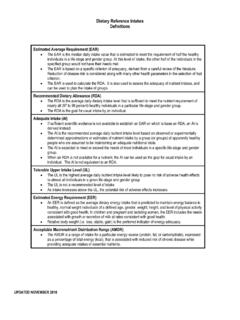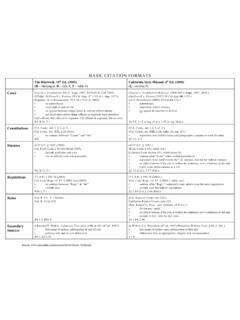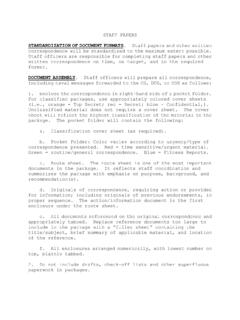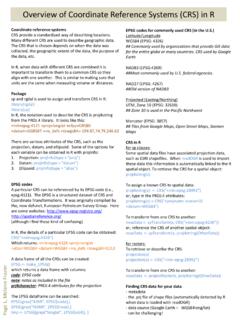Transcription of SEG-Y r2.0: SEG-Y revision 2.0 Data Exchange format SEG ...
1 : SEG-Y revision Data Exchange format1 SEG Technical Standards Committee2 January 20171 2017, Society of Exploration Geophysicists. All rights reserved. 2 Editors Rune Hagelund and Stewart A.. FROM REV 1 TO REV FROM REV 0 TO REV FILE STRUCTURE .. TRACE FILE HEADER .. FILE HEADER ..6 Byte .. 10 Description .. TEXTUAL FILE HEADER .. OF EXTENDED TEXTUAL TRACES .. HEADER STANZA AND DATA TRAILER .. 27 APPENDIX A. WRITING SEG-Y DATA TO A DISK 28 APPENDIX B. SEG-Y TAPE 29 APPENDIX C. BLOCKING OF SEG-Y FILES ON TAPE .. 32 APPENDIX D. EXTENDED TEXTUAL REFERENCE SYSTEM DEFINITION: INTERNATIONAL ASSOCIATION OF OIL ANDGAS PRODUCERS P1/11 .. format LOGICAL FILE RECORD DATA TYPES USED IN THE format RECORD DATA TYPES [DATATYPEREF] .. COMMON HEADER: FILE IDENTIFICATION COMMON HEADER: REFERENCE SYSTEM UNIT REFERENCE SYSTEMS COORDINATE REFERENCE SYSTEMS January Coordinate Reference System Implicit Identification.
2 Coordinate Reference System Explicit Definition .. Coordinate Transformation Implicit Identification .. Coordinate Transformation Explicit Definition .. Example Point Conversion .. COMMENT EXAMPLE CRS DATA GEOGRAPHIC EXTENT USING OGP P1/11:.. BIN GRID DEFINITION: IOGP P6 P6 HEADER: FILE CONTENT BIN NODE POSITION DEFINITION USING OGP P6 COVERAGE PERIMETER DEFINITION USING OGP P6/11: .. REFERENCE SYSTEM DEFINITION (DEPRECATED) .. GRID DEFINITION: GEOGRAPHIC EXTENT & COVERAGE PERIMETER (DEPRECATED) .. SAMPLE MEASUREMENT MEASUREMENT FOR TRACE HEADER DATA 128 APPENDIX E. DATA WORD format .. 137 APPENDIX F. EBCDIC AND ASCII 143 APPENDIX G. REFERENCES .. 146 FIGURESFIGURE 1 BYTE STREAM STRUCTURE OF A SEG-Y 2 STRUCTURE OF A USER HEADER OR DATA TRAILER CONTAINING N DATA BLOCKS.. 27 FIGURE 3 BIN GRID DEFINITION (RIGHT-HANDED CASE) .. 105 FIGURE 4 VARIOUS DATA EXTENTS AND COVERAGE PERIMETERS FOR A SEISMIC 109 FIGURE 5 STRUCTURE OF A USER DATA STANZA CONTAINING N DATA 128 TABLESTABLE 1 TEXTUAL FILE 5 TABLE 2 BINARY FILE 3 STANDARD TRACE 15 TABLE 4 TRACE HEADER EXTENSION 1.
3 24 TABLE 5 PROPRIETARY TRACE HEADER 27 TABLE 6 SEG-Y TAPE 29 TABLE 7 STANZA FOR IMPLICIT IDENTIFICATION OF LOCATION 79 TABLE 8 STANZA FOR EXPLICIT DEFINITION OF LOCATION 80 TABLE 9 STANZA FOR IMPLICIT IDENTIFICATION OF LOCATION DATA 95 TABLE 10 STANZA FOR EXPLICIT IDENTIFICATION OF LOCATION DATA 96 TABLE 11 STANZA FOR BIN GRID 105 TABLE 12 STANZA FOR DATA GEOGRAPHIC 110 TABLE 13 STANZA FOR COVERAGE 111 TABLE 14 STANZA FOR DATA SAMPLE MEASUREMENT 114 TABLE 15 STANZA FOR PROCESSING January 2017iiiTABLE 16 STANZA FOR SOURCE 116 TABLE 17 STANZA FOR SOURCE MEASUREMENT 116 TABLE 18 STANZA FOR TRACE HEADER 117 TABLE 19 IBM 3270 CHAR SET January 2017iv1. IntroductionSince the original SEG-Y Data ExchangeFormat ( revision 0, - see Appendix ) was published in 1975 it hasachieved widespread usage within thegeophysical industry. The 2002 revision 1extended the standard to 3-D acquisitionand high capacity media, reducing, thoughfar from eliminating, the use of proprietaryvariations.
4 Since the publication of SEG-Yrev 1, the nature of seismic data acquisition,processing and seismic hardware hascontinued to evolve and the SEG TechnicalStandards Committee undertook furtherrevision. In line with the 2011 SEG D rev , this revision both addressescurrent industry data Exchange needs andprovides an explicit mechanism to supportfuture expansion with both proprietary andofficially-adopted extensions. The SEGT echnical Standards Committee stronglyencourages producers and users of SEG-Ydata sets to move to the revised standard inan expeditious of this standard are cautioned thatSEG-Y was not explicitly designed for useas a field recording format . The SEG D orSEG 2 formats are recommended for Unchanged Items EBCDIC encoding allowed for text The size of the original 3200-byteTextual File Header, 400-byte BinaryFile Header and initial 240-byte Changes from rev 1 to rev 2 Provide for up to 65535 additional 240byte trace headers with bytes 233-240of each trace header reserved for traceheader names Allow up to 232 1 samples per trace Allow arbitrarily large and small sampleintervals Permit up to 264 1 traces per line and232 1 traces per ensemble Support additional data sample formats,including IEEE double precision (64 bit) Support little-endian and pair-wise byteswapping to improve I/O performance.
5 Support microsecond accuracy in timeand date stamps Support additional precision oncoordinates, depths and elevations(especially useful for lat/long and UTMcoordinates) and more options forcoordinate reference systemspecification Require Extended Textual File Headerstanzas to begin at 3200-byteboundaries and removed 40 80-byte linerestriction Allow stanzas to appear after the lastdata trace Provide flexible trace header mappingoptions via Extended Textual FileHeaders. Because of this ability, weremove almost all mandatory and highly recommended header entrydesignations Allow XML-based Extended Textual FileHeader and Trailer stanzas for ease ofmachine encoding and decoding Include depth, velocity, EM, gravity androtational sensor Changes from rev 0 to rev 1 A SEG-Y file may be written to anymedium that is resolvable to a stream ofvariable length records The data word formats are expanded toinclude four-byte, IEEE floating-pointand one-byte integer data words A small number of additional fields in the400-byte Binary File Header and January 20171240-byte Trace Header are defined andthe use of some existing entries isclarified An Extended Textual File Headerconsisting of additional 3200-byteTextual File Header blocks is introduced The data in the Extended Textual FileHeader uses a stanza layout andstandard stanzas are defined Trace identification is expanded Engineering conversions are introduced The Textual File Header and theExtended Textual File Header can beencoded as EBCDIC or NotationThe term CDP (common depth point) asused in this document is used as a synonymfor the term CMP (common midpoint).
6 Controlling OrganizationSEG-Y is administered by the SEGT echnical Standards Committee. Anyquestions, corrections or problemsencountered in the format should beaddressed to:Society of Exploration Box 702740 Tulsa, Ok 74170-2740 Attention: SEG Technical StandardsCommitteePhone: (918) 497-5500 Fax: (918) 497-5557 Internet site: AcknowledgmentsThe SEG Technical Standards Committeewould like to acknowledge the time andeffort put forth by a great many individualsand SEG-Y File StructureThe SEG-Y format is intended to beindependent of the actual medium on whichit is recorded. For this standard, the termsfile and data set are synonymous. Bothterms are a collection of logically relateddata traces or ensembles of traces and theassociated ancillary Recording MediumA SEG-Y file may be written to anysequential medium. Whatever medium isused, the data must be resolvable to astream of variable length logical includes high capacity tape devices,although with these it is desirable to usesome kind of blocking and/or logicalencapsulation such as SEG RODE (Boothet al.)
7 , 1997), to use the tape more efficientlyand possibly to allow the recording ofassociated metadata. Obviously, whenseismic data are being exchanged in SEG-Yformat, the medium and any blocking and/orencapsulation scheme used must beacceptable to both the provider andrecipient of the 1 Byte stream structure of a SEG-Y file with N Extended Textual File Header records and M tracesrecords3200byteTextualFileHeader40 0byteBinaryFileHeader1st 3200byteExtendedTextualFileHeader(Option al)MthDataTraceOptional128 byteSEG-YTapeLabel1stDataTraceDataTraile r1 or more3200 byterecords(Optional)Nth 3200byteExtendedTextualFileHeader(Option al)1 or more240 byteTrace 1 Headers1 or more240 byteTrace January 20172 One important class of media on whichSEG-Y data are exchanged is the bytestream without any record structure. It iscommon practice to write SEG-Y data todisk, including USB sticks, CD and DVD-ROM, or streamed through a network fordata distribution. Certain rules have to befollowed for this to work correctly.
8 AppendixA defines how SEG-Y data should bewritten as a byte order to make SEG-Y consistent with theSEG D Rev standard, Appendix Bdefines a tape label for SEG-Y tapes, usinga format based on the RP66 Storage UnitLabel. Labels are not mandatory for SEG-Y , but their use is highly desirable inenvironments such as robotic tape librariesand large scale processing C defines a simple blockingscheme for SEG-Y data to allow moreefficient use of high-capacity tape is based on the scheme defined in theSEG D Rev File StructureFigure 1 illustrates the structure of a SEG-Yfile. Following the optional SEG-Y TapeLabel, the next 3600 bytes of the file are theTextual File Header and the Binary FileHeader written as a concatenation of a3200-byte record and a 400-byte is optionally followed by ExtendedTextual File Header(s), which consists ofzero or more 3200-byte Extended TextualFile Header records. The remainder of theSEG-Y file contains a variable number ofData Trace records that are each precededby a 240-byte Standard Trace Header andzero or more 240-byte Trace HeaderExtensions.
9 The Trace Header Extensionmechanism is the only structural changeintroduced in this revision and while notstrictly backward compatible with prior SEG-Y formats, it has been carefully designed tohave minimal impact on existing SEG-Yreader software. It should be simple forexisting software to be modified to detectthe presence of the optional trace headersand either process or ignore any ProprietaryTrace Header Extensions. The format ofTrace Header Extensions is described fullyin section Number FormatsIn earlier SEG-Y standards, all binaryvalues were defined as using big-endian byte ordering. This means that, within thebytes that make up a number, the mostsignificant byte (containing the sign bit) iswritten closest to the beginning of the fileand the least significant byte is writtenclosest to the end of the file. With SEG-Yrev 2, little-endian and pairwise byte-swapped byte ordering are allowed,primarily for I/O performance. This isindependent of the medium to which aparticular SEG-Y file is written ( the byteordering is no different if the file is written totape on a mainframe or to disk on a PC).
10 These alternate byte orders are identified byexamining bytes 3297-3300 in the BinaryFile Header and apply only to the BinaryFile Header, Trace Headers, and values in the Binary File Header and theSEG defined Trace Headers are to betreated as two's complement integers,whether two, four or eight bytes long, withthe exception of the new 8-character TraceHeader Extension name, an optional IEEE double precision sample rate, and fields thatcannot be negative such as the number ofsamples per trace. To aid in data recogni-tion and recovery, a value of zero in anySEG or user assigned fields of theseheaders should indicate an unknown orunspecified value unless explicitly Data sample values are eitherintegers or floating-point numbers. Signedintegers are in two s complement revision 2 adds unsigned integers, 3 Textual Headers and Data Trailer recordsare always assumed to be text and so byteordering is left January 2017324 and 64 bit integers and IEEE floating-point data sample Varying Trace LengthsThe SEG-Y standard specifies fields forsample interval and number of samples attwo separate locations in the file.








